
Benevento is a city and comune of Campania, Italy, capital of the province of Benevento, 50 kilometres (31 mi) northeast of Naples. It is situated on a hill 130 metres above sea level at the confluence of the Calore Irpino and the Sabato. In 2020, Benevento has 58,418 inhabitants. It is also the seat of a Catholic archbishop.

Campobasso is a city and comune in southern Italy, the capital of the region of Molise and of the province of Campobasso. It is located in the high basin of the Biferno river, surrounded by Sannio and Matese mountains.

The province of Benevento is a province in the Campania region of Italy. Its capital is the city of Benevento.
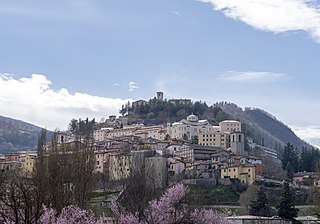
Cascia is a town and comune (municipality) of the Italian province of Perugia in a rather remote area of the mountainous southeastern corner of Umbria. It is about 21 km from Norcia on the road to Rieti in the Lazio (63 km). It is also very close to Terni.

Jesi is a comune (municipality) in the province of Ancona, in the Italian region of Marche.
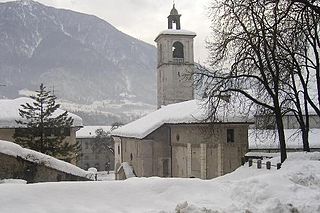
Feltre is a town and comune of the province of Belluno in Veneto, northern Italy. A hill town in the southern reaches of the province, it is located on the Stizzon River, about 4 kilometres from its junction with the Piave, and 20 km (12 mi) southwest from Belluno. The Dolomites loom to the north of the town.

Ponte is the name of a town and comune in the Province of Benevento, Campania Region, Italy. It is a member of the Titerno "Local Action Group" (GAL) and its name means bridge in Italian.

Alvito is a town and comune in central Italy, in the province of Frosinone, south of Rome in the Lazio region. Its territory is included in the Abruzzo, Lazio and Molise National Park.

Forenza is a town and comune in the province of Potenza, Basilicata, southern Italy. It is bounded by the comuni of Acerenza, Avigliano, Filiano, Ginestra, Maschito, Palazzo San Gervasio, Pietragalla, Ripacandida.

Campagna is a small town and comune of the province of Salerno, in the Campania region of Southern Italy. Its population is 17,148. Its old Latin name was Civitas Campaniae. Campagna is located in one of the valleys of the Picentini Mountains, at an altitude of 270 meters above sea level.

Celano is a town and comune in the Province of L'Aquila, central Italy, 120 km (75 mi) east of Rome by rail.

Mirabello Sannitico is a small town in the province of Campobasso, Molise, southern Italy. The population is about 2,100 inhabitants. It has an agrarian-based culture and history, dating back to at least the 12th century. Nearby towns include Campobasso to the northwest and Vinchiaturo to the southwest. The Tappino River flows on either side of the town on the north and south.

Potenza is a comune in the Southern Italian region of Basilicata.

Alife is a town and comune in the Province of Caserta (Campania), Italy. It is located in the Volturno valley, and is a flourishing centre of agricultural production. The comune was formerly inhabited by Arbëreshë and Jewish communities, who have since assimilated.
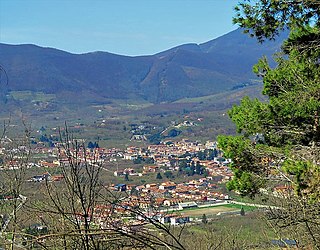
Forino is a town and comune in the province of Avellino, Campania, southern Italy.

Conza della Campania is a comune (municipality) and former Latin Catholic (arch)bishopric in the province of Avellino in the region of Campania in southern Italy.
Carosino is a town and comune in the province of Taranto, in the northern Salento, part of the Apulia region of southeast Italy. Carosino was historically an Arbëreshë settlement. Its economy is based on the production of wine, olive oil and grapes.
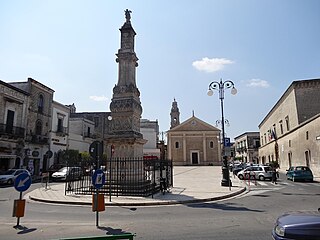
Sava is a town and comune in the province of Taranto, Apulia, southeast Italy. With its 19000 inhabitants, is one of the biggest town in the province.
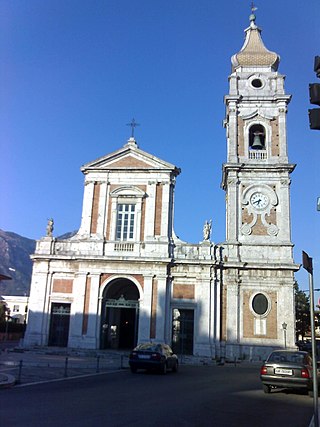
Airola is a comune (municipality) in the Province of Benevento in the Italian region Campania, located about 35 km northeast of Naples and about 20 km southwest of Benevento in the Valle Caudina, facing the Monte Taburno. Nearby is the confluence of the Tesa and Faenza streams into the Isclero River. Airola's territory is also crossed by the Acquedotto Carolino, carrying waters to the Caserta Palace.

Fragneto l'Abate is a comune (municipality) in the Province of Benevento in the Italian region Campania, located about 70 kilometres (43 mi) northeast of Naples and about 15 kilometres (9.3 mi) north of Benevento.























